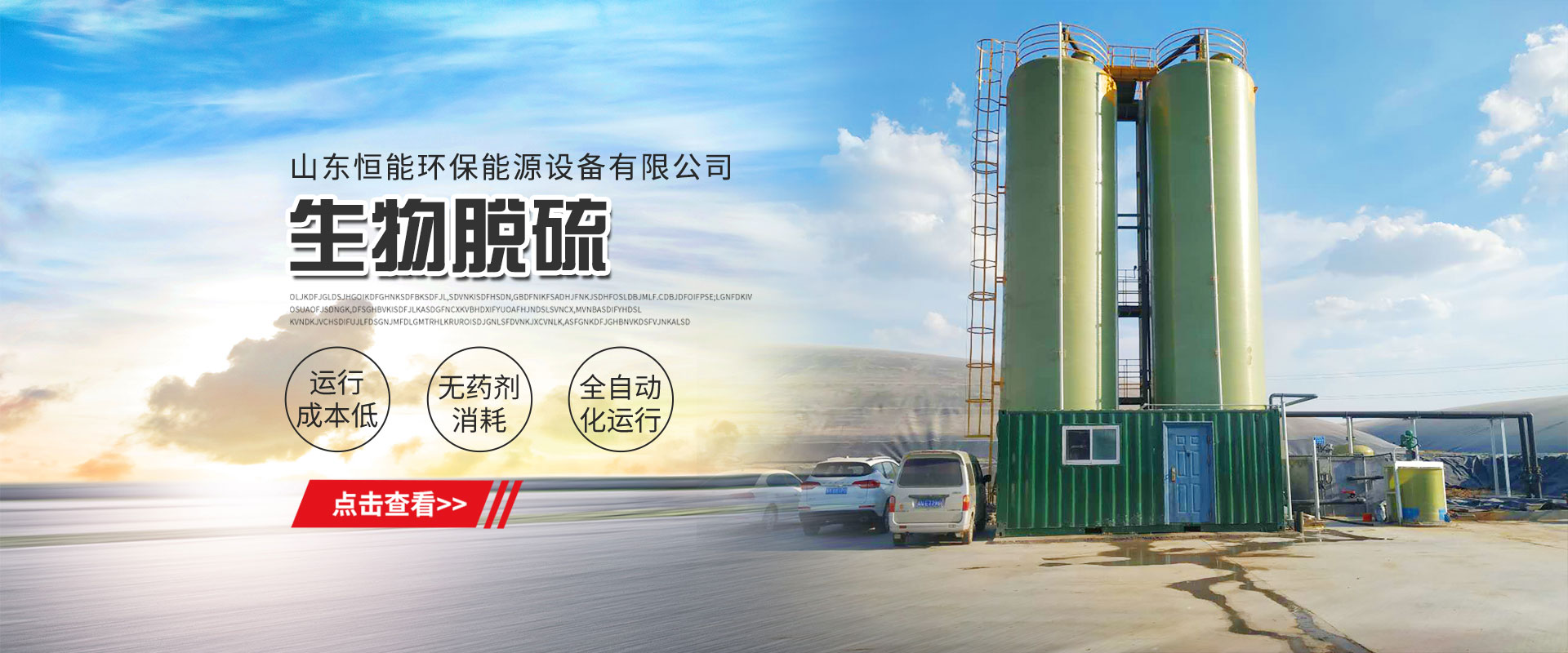沼气从脱硫塔的一端,经过填料层(主要成分是活性炭和氧化铁)净化后,从另一端流出。硫化氢与填料层的氧化铁发生反应,生成硫化铁;待氧化铁反应结束后,可进行再生。
Biogas flows from one end of the desulfurization tower through a filler layer (mainly composed of activated carbon and iron oxide) after purification, and then flows out from the other end. Hydrogen sulfide reacts with iron oxide in the filler layer to generate iron sulfide; After the completion of the iron oxide reaction, regeneration can be carried out.
脱硫原理:
Desulfurization principle:
再生原理:
Regeneration principle:
湿法脱硫
Wet desulfurization
湿法脱硫是将沼气送入洗涤塔,经碱性溶液洗涤吸收后流出,洗涤液进入富液槽、再生槽,通过使用化学药剂方法催化、氧化,zui终将硫化物转化为单质硫(硫泡沫),吸收液可以再生循环使用。
Wet desulfurization is to send biogas into the scrubber, wash and absorb it with alkaline solution, and then flow out. The washing solution enters the rich solution tank and regeneration tank. Through catalysis and oxidation with chemical agents, zui will eventually convert sulfide into elemental sulfur (sulfur foam), and the absorption solution can be recycled for use.、
生物脱硫
Biological desulfurization
生物脱硫也是湿法脱硫的一种,与上述湿法脱硫的催化氧化工艺相比,zui大区别是使用硫杆菌替代化学催化剂,将硫化物直接氧化成硫单质。
Biological desulfurization is also a type of wet desulfurization. Compared to the catalytic oxidation process of wet desulfurization described above, the major difference in Zui is the use of Thiobacillus instead of chemical catalysts to directly oxidize sulfides into sulfur elemental substances.
反应原理:
Reaction principle:
说明:
explain:
干法脱硫多用于硫化氢处理负荷小,或者对脱硫效果要求很高的工况。这时,干法脱硫多用于湿法脱硫或者生物脱硫之后,进一步脱硫。
Dry desulfurization is often used under conditions where the hydrogen sulfide treatment load is small or the desulfurization effect is highly required. At this time, dry desulfurization is often used for further desulfurization after wet desulfurization or biological desulfurization.
在制定脱硫效果时,建议根据后续设备(锅炉或发电机)对硫化氢浓度的限制,以及沼气与天然气消耗量的比例,制定一个合理的脱除效果。我们通常建议zui终的硫化氢含量控制在25~100ppm。
When formulating a desulfurization effect, it is recommended to establish a reasonable removal effect based on the limits on hydrogen sulfide concentration of subsequent equipment (boilers or generators) and the ratio of biogas to natural gas consumption. We generally recommend that the hydrogen sulfide content of the Zui terminal be controlled between 25 and 100 ppm.
沼气脱水的方法
Methods of biogas dehydration
从发酵装置出来的沼气含有饱和水蒸气,可用3种方法将其去除。
The biogas from the fermentation device contains saturated water vapor, which can be removed by three methods.
冷分离法。
Cold separation method.
冷分离法是利用压力能变化引起温度变化,使水蒸气从气相中冷凝下来的方法。常用的有两种流程:A.节流膨胀冷脱水法。一般用于高压燃气,经过节流膨胀或低温分离,使部分水冷凝下来。B.加压后冷却法。如净化气在0.8MPa压力下的冷却脱水
Cold separation method is a method that utilizes changes in pressure energy to cause temperature changes and condense water vapor from the gas phase. There are two commonly used processes: A. Throttling expansion cold dehydration method. Generally used for high-pressure gas, through throttling expansion or low-temperature separation, to condense some water. B. Pressurized post cooling method. For example, cooling and dehydration of purified gas at a pressure of 0.8MPa
溶剂吸收法。属于这类脱水溶剂的有氯化钙、氯化锂及甘醇类。
Solvent absorption method. Calcium chloride, lithium chloride, and glycols belong to this category of dehydration solvents.
固体物理吸水法。吸附是在固体表面力作用下产生的,根据表面力的性质分为化学吸附脱水后不能再生)和物理吸附
Solid physical water absorption method. Adsorption is generated under the action of solid surface forces, which can be divided into chemical adsorption (which cannot be regenerated after dehydration) and physical adsorption according to the nature of surface forces
新闻中心




